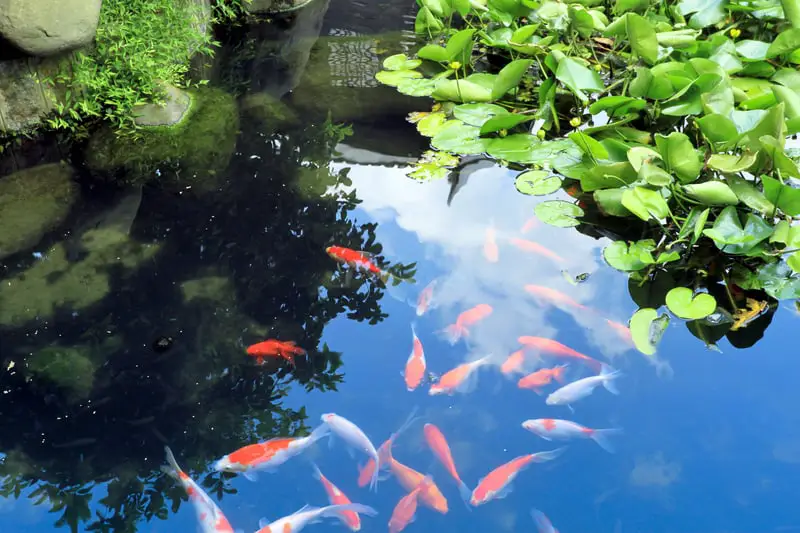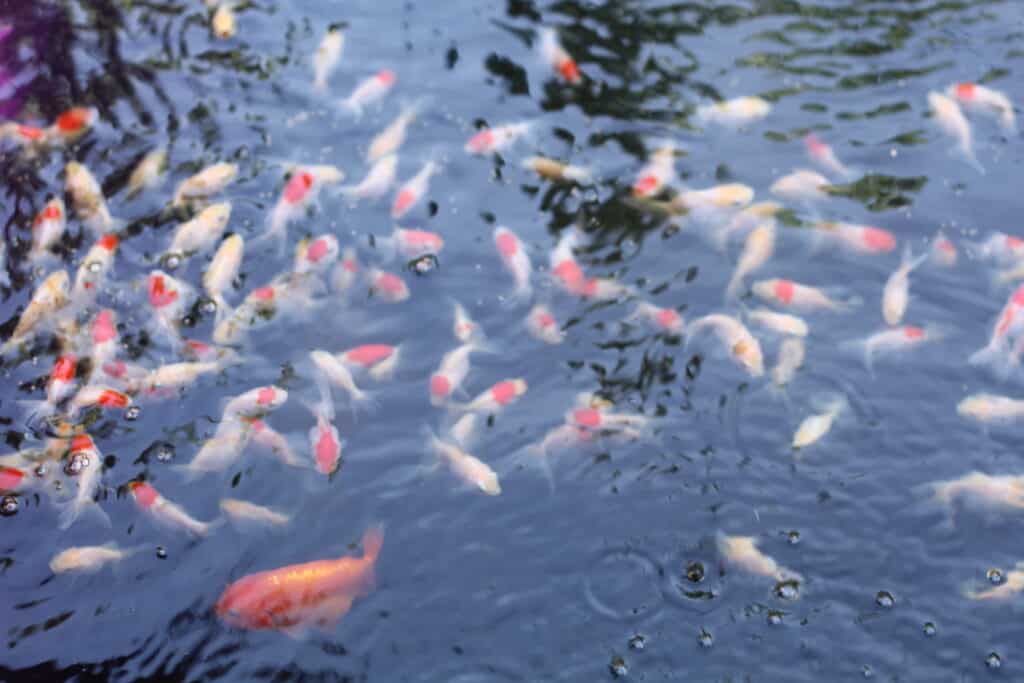
A healthy Koi pond is something that all Koi owners strive for. Unfortunately, there are so many different old wives’ tales that it becomes hard to divide the truth from fiction. The reality is that a well-designed, optimally filtered Koi pond requires very little maintenance or problem-solving.
You can’t over filter a koi pond, and if you suspect that you are because the water is unnaturally clear and you constantly have to clean out the filter screens, you may have the incorrect grade screens installed. Fish thrive in oxygenated water, which is regularly cleaned of harmful bacteria.
While koi do not naturally live in water that is completely clean without any algae or weeds, it is not harmful to them to exist in this kind of OCD environment. Water, which is not filtered, murky or oxygenated, is much more detrimental to the koi’s health.
Pro Tip: If you’re tired of wasting money and making costly mistakes on the koi-keeping hobby or are thinking about buying koi fish but don’t know where to start, I strongly suggest you check out this ebook. I recently read this ebook, and it contains SO much useful information, such as:
- 3 proven steps to identify koi fish diseases
- WARNING: 3 things you should NEVER do when it comes to caring for koi
- When to seek professional help when it comes to looking after your koi
You Cannot Over Filter A Koi Pond.
In a natural river system, lake or dam, fish exist and thrive without artificial filters.
If the water body is large enough, the currents will remove any waste matter; however, in a smaller system, while the Carp (Koi) will thrive, they are often considered an invasive species.
- Stir up the substrate, causing the water to become murky and making it hard for plants to root.
- Koi can make the water undrinkable for both human and animal consumption.
While it is true that a filtration system controls the environment artificially if the filters are removed, there would be no aeration of the water, and it would become toxic for the fish.
- The fish would die
- The plants would not thrive.
As it’s essential to remove all solids, harmful waste, or bacteria, you cannot over-filter a koi pond.
Filtering the water in your Koi pond serves three purposes.
It Removes Waste From The Pond
Filters’ most apparent function is to physically separate and remove any wastes or solids from the pond, clarifying the water.
While making the pond look clean is essential, there is a greater need to constantly rehabilitate the medium by removing harmful bacteria and fish waste.
As the solid waste comes in different sizes, they need to be filtered out by a multiple-stage system.
The stages allow the water particulates to first pass through the filter material with the biggest pores and trap the largest debris. In the subsequent steps, pore size gets smaller, and finer particulates are removed.
It Removes Harmful Bacteria Form The Water
Although the Koi pond water may be crystal clear, if toxic substances like ammonia dissolved in the water are not removed, the pond health will be affected.
Both solid waste and toxic substances must be visually removed and must also be decomposed and purified.
Filters Oxygenate The Water
Every living thing requires oxygen to live, and the same is true for the koi in a pond that requires a constant supply of oxygen. Because of this, it is vital that you adequately aerate your koi pond.
The koi, plants, and even the bacterium in the filter pads need enough oxygen.
The best aeration method in a koi pond is to move from the bottom surface and return it to the top. It takes the bottom low dissolved oxygen (poorly aerated) and sends it up to come in contact with the oxygen at the surface.
If you have a waterfall or similar feature, water movement also oxygenates the water.
Twenty-four hours a day, constant circulation is needed to maintain proper aeration in a koi pond.
Can You Run 2 Filters In A Pond?
If your filter pump is powerful enough, you can run two filters parallel with each other.
Be careful; however, while you may have two filters, the flow of water through them will be halved.
Unless you intend to have two different functioning devices (mechanical and bacterial), there will be little benefit in having two filters running off the same pump.
Problems With Koi Pond Filters
If you are struggling with the Koi pond filter, it is probably not because you have been running it too long but because the system has a problem.
The Filters Screen Are Constantly Blocked
Filter screens constantly becoming blocked are not caused by over-filtration but rather by the incorrect specification screens used.
If the filter screens are designed to collect too small a material, they will catch the smallest of microscopic particles; you will probably find that you constantly have to remove the media and rinse it.
This remedy does not reduce the filtration time; instead, changing the filter screens to a coarser grade should rectify the situation.
There Is An Excessive Water Flow
If the water flow is very rapid and the fish constantly have to fight against currents, it is an indication that the pump is too powerful. You should reduce the power setting (if possible) or change the pump to a less powerful model.
The pump and pond filtration system only needs to turn over the contents of the water once an hour. If your pump exceeds this rate, it is operating too powerfully.
Types Of Filtration Systems Available For A Koi Pond

Effective filtration systems are a sieve, bubble bead filters, and RDF (Rotating Drum Filter) systems.
A biofilter’s function is to provide a protected home for the bacterial colonies, enabling them to react in real-time to the ammonia waste produced by the fish.
Sieve Filters
Sieve filter systems consist of hundreds of triangular sticks spaced 0.2 – 0.3 mm (200 to 300 microns) apart.
The rods are slightly tilted, which causes the bigger dirt particles to remain on the sieve while the filtered ‘sieved’ water drains through and the cleaned water is pumped to the primary filter.
While the filter removes larger particles from the water, the sieve has a layer of nitrifying bacteria growing in it.
The nitrifying bacteria in the triangular sticks convert the ammonia (fish waste) in the water into a healthy nitrate which the plants absorb to enable their growth.
RDF (Rotating Drum Filter)
A rotating drum filter system (Paddle Wheel Filter or a Water Wheel Filter) comprises a cylinder of corrugated, highly porous 200–300 micron-sized screens to filter water.
The Drum turns like a paddle wheel on an old Mississippi old riverboat with only one edge in the water at any time. It provides an oxygen-rich filtration environment.
As the drum rotates, it filters out the ammonia-laden fish waste.
As the drum turns, the nitrifying bacteria in the filters convert the ammonia from the fish waste into nitrate compounds, the majority of which are then absorbed by the plants, and the small amount which is not absorbed is left in a relatively harmless state.
Bubble Bead Filter
A Bubble bead filter is essentially an upside-down sand filter that uses tiny plastic beads that float instead of sand.
Bubble bead filters pump water UP through the floating bead bed. The bead filter operates more or less like a sand filter, just upside down. And the filtration method is like a conventional sand filter.
When the filter is back washed, a powerful air blower installed on the side of the filter is activated. The incoming air churns the water up and effectively cleans the beads off.
Once the blower has done its thing, the filter tank is backwashed, and the dirty water removed.
Comment On Filters
Any of the above filters are better than traditional sand filtration units.
The problem is that sand filters are very effective at trapping the dirt. Unfortunately, if it is not cleaned, the dirt rots and breeds pathogenic bacteria and toxic, harmful chemicals, eventually reentering the Koi pond and impacting the fish’s health.
Conclusion
It is impossible to over-filter a Koi pond because removing solid debris, waste, and harmful bacteria adds to the pond’s health and cannot compromise it. If your pond looks unnaturally clear, but you constantly have to clean the filters, you may have the wrong filters installed.
If the water flow is too fast and the koi are not thriving, it may be because the filter pump is running too powerfully.
References
https://www.water-garden.co.uk/blog/can-you-over-filter-a-pond


